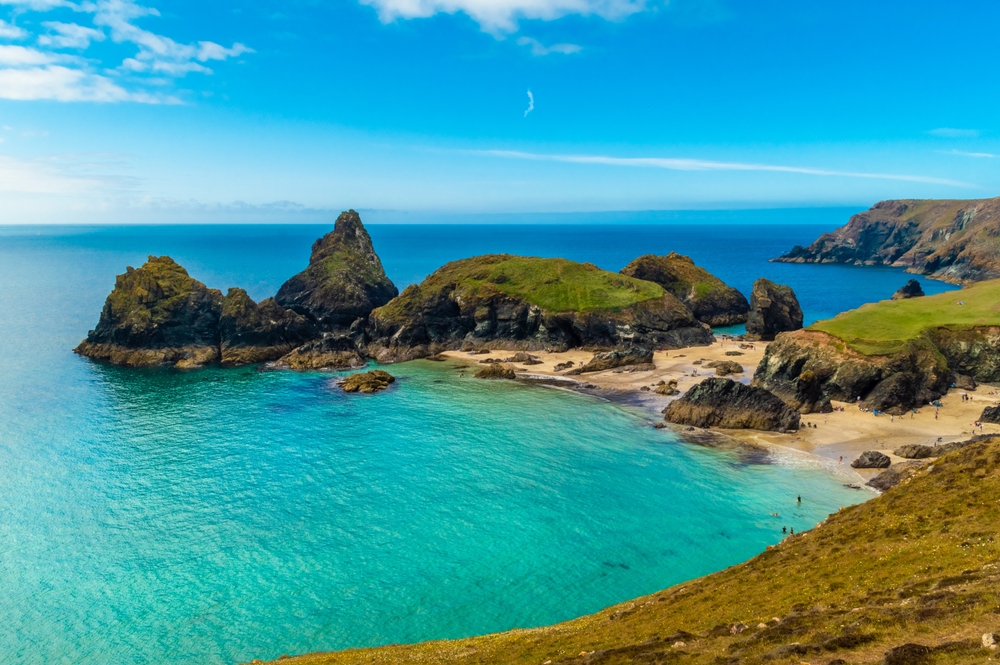Geology feels like a particularly present and powerful force in Cornwall. Pushing up the stark rocky tors of the moors, creating dynamic and dramatic coastal landscapes and driving industry and commerce for hundreds of years. The Cornish have always benefited from its harvest and tried their best to master it, above and below ground. From tin, copper, gold, silver, granite and china clay to arsenic, zinc, tungsten and most recently lithium Cornwall’s terrain has always been very fruitful.
But those geological idiosyncrasies are perhaps at their most striking and beautiful on the Lizard Peninsula. The area is famed for its unusual rocks and minerals as well as some rare and rather peculiar geological features. For example, visitors can see an piece of the earth’s mantle (that should be 7km beneath the surface) exposed on a beach at Coverack. But it is the spectacle geology of Kynance Cove that has been wowing geologists, poets, tourists and royalty for hundreds of years and is the focus of this article.
Kynance Cove is just a short walk from the Lizard Point, the most southerly place in Britain, but offers one of the most beautiful landscapes in Cornwall.
One of the most extraordinary spots on our coast
When physician to the Royal family, George William Maton, visited the cove in 1794 he called it “one of the most extraordinary spots on our coast.”
Crystal clear waters lap at serpentine rock making the brilliant reds and greens of this rare stone even more vibrant. A number of tidal islands and stacks, with names like The Bishop, Steeple Rock, Lion Rock and Asparagus Island, stand just offshore adding to the pleasing beauty of the scene.
With the wind and the waves in the right direction a sort of bizarre snorting noise can be heard coming from Asparagus Island – the sound is the ‘Devil’s Bellows’, a blowhole caused by the sea tunnelling along a fault in the rock. But it is the serpentine that has been bringing people here for hundreds if not thousands of years.
Serpentine Marble and the Royal Family
Serpentine is a kind of marble, formed around 350 million years ago, and although it can be found in other parts of Britain and Europe, nowhere in the world are the colours and patterns of this stone as bright and as varied as they are on the Lizard and particularly at Kynance.
Historically this stone has been cut and polished to make decorative items since at least the 17th century. There are monuments in Westminster Abbey made from Cornish serpentine and craftsmen on the Lizard have been making mantle pieces, vases, columns, church lecterns and innumerable trinkets from this attractive stone for centuries but a Royal visit in the mid-19th century saw serpentine explode in popularity.
In September 1846 Queen Victoria and her family were touring the coast of Cornwall in the Royal Yacht, Fairy. They had already visited St Michael’s Mount, where the Queen’s tiny footprint cast in brass can still be seen on the quay of the island today, and they were making their way back towards Falmouth when Prince Albert asked for a short excursion.
The Prince had always appeared interested in local industry and during a visit to Penzance the day before he had been shown some examples of serpentine. Intrigued he was apparently determined to see the rock in its natural state. The Royal yacht anchored just off Kynance Cove so that Albert could row ashore, he was delighted with what he saw.
In the end the whole Royal party, including the Queen, spent a few happy hours on the beach there and the couple were so impressed with the colour of the stone that they ordered several pieces of decorative serpentine for their home on the Isle of Wight. As soon as word spread of this Royal endorsement the national infatuation for Cornish serpentine began!
It was a love affair that would continue right through the Victorian period with dozens of serpentine workshops and factories springing up on the Lizard. There were even boat trips from Falmouth during the summer months bringing hordes of tourists every day to Church Cove just so that they could walk up the hill to the village and see the craftsmen at work and then take home a serpentine souvenir.
Kynance Cove delights visitors, writers and artists
Kynance Cove also continued to delight visitors, especially writers and artists. The poet Lord Tennyson visited in 1848 and wrote in his diary: “Glorious grass-green monsters of waves. Into caves of Asparagus Island. Sat watching wave-rainbows.” While Rev Francis Kilvert recorded in 1870 that he “never saw anything like the wonderful colour of the serpentine rocks, rich, deep, warm, variegated, mottled and streaked and veined with red, green and white . . . an enchanted cove.”
Today Kynance Cove continues to charm and delight those that venture far enough south in Cornwall. The coastline here is dramatic whatever the time of year, choughs can be seen catching the updraughts, seals are common bobbing in the waves and everywhere is the gleam of serpentine, from the pebbles on the beaches to architectural features and the stiles in the hedges.
The cove is now cared for by the National Trust and there is a carpark and café on the cliffs above the beach, housed in the little cottages that were once home to serpentine craftsmen. A couple of workshops still survive in Lizard Village so you can still take home a polished stone souvenir like so many have before you.
